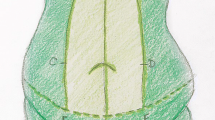Abstract
Introduction
Combined and/or multistage operations often are needed in postbariatric surgery.
Aim
With this retrospective study of a series of 55 cases, we aim to determine the effectiveness and safety of one-stage combined postbariatric surgery.
Materials and Methods
A total of 248 postbariatric procedures were performed in one session (except one-staged gynecomastia case) in 55 patients. The procedures included face and neck lifting, upper and lower trunk lifting, gluteal fat injection, mammoplasty, gynecomastia correction, abdominoplasty, and thigh and arm lifting. Sagged tissues of the trunk and extremities were removed by avulsing after tumescent liposuction. Liposuction was performed also on the neighboring tissues. Multilayer repair from superficial fascia to the skin was carried out after meticulous hemostasis and suction drain insertion.
Results
At least two plastic surgeons and two assistants entered the operations; operation time never exceeded 4.5 h except in one, and blood transfusion was needed only in one case. All patients were discharged from the hospital after 1 or 2 nights. Postoperative problems included infection (3.64% of the patients), delayed wound healing after seroma formation (32.73%), abnormal scar formation (1.82%), and demanded scar revision and revisionary liposuction by 10 patients (18.18%).
Conclusion
Combined postbariatric operations are very effective and the likelihood of serious complications could be decreased significantly when performed under certain conditions. The tumescent dermolipectomy method is a very useful method for these cases.
Level of Evidence IV
This journal requires that authors assign a level of evidence to each article. For a full description of these Evidence-Based Medicine ratings, please refer to the Table of Contents or the online Instructions to Authors www.springer.com/00266.
















Similar content being viewed by others
References
Coon D, Joseph M, Gusenoff JA et al (2010) Multiple procedures and staging in the massive weight loss population. Plast Reconstr Surg 125:691–698
Hurwitz DJ, Agha-Muhammadi S, Ota K et al (2008) A clinical review of total body lift surgery. Aesthet Surg J 28:294–303
Costa-Ferreira A, Rebelo M, Vasconez LO et al (2010) Scarpa fascia preservation during abdominoplasty: a prospective study. Plast Reconstr Surg 125:1232–1239
Hurwitz DJ, Holland SW (2006) The L brachioplasty: an innovative approach to correct excess tissue of the upper arm, axilla, and lateral chest. Plast Reconstr Surg 117:403–411
Agha-Mohammadi S, Hurwitz DJ (2006) Postbariatric surgery breast reshaping the spiral flap. Ann Plast Surg 56:481–486
Song AY, Jean RD, Hurwitz DJ et al (2005) A classification of contour deformities after bariatric weight loss: the Pittsburgh rating scale. Plast Reconstr Surg 116:1535–1544
Hurwitz DJ (2012) J Torsoplasty: a novel approach to avoid circumferential scars of the upper body lift. Plast Reconstr Surg 130:382e–383e
Hurwitz DJ (2014) Aesthetic refinements in body contouring in the massive weight loss patient: trunk. Plast Reconstr Surg 134:1185–1195
Hurwitz DJ (2015) Boomerang pattern correction of gynecomastia. Plast Reconstr Surg 135:433–436
Hurwitz DJ, Rubin P, Risin M et al (2004) Correcting the saddlebag deformity in the massive weight loss patient. Plast Reconstr Surg 114:1313–1325
Agha-Mohammadi S, Hurwitz DJ (2010) Enhanced recovery after body-contouring surgery: reducing surgical complication rates by optimizing nutrition. Aesthet Plast Surg 34:617–625
Costa-Ferreira A, Rebelo M, Silva A et al (2013) Scarpa fascia preservation during abdominoplasty: randomized clinical study of efficacy and safety. Plast Reconstr Surg 131:644–651
Hall-Findlay EJ (2002) Vertical breast reduction with a medially-based pedicle. Aesthet Surg J 22:185–194
Lejour M (1999) Vertical mammaplasty: update and appraisal of late results. Plast Reconstr Surg 104:771–781
Lassus C (1986) An “all-season” mammoplasty. Aesthet Plast Surg 10:9–15
Luis O. Vasconez’s aesthetic fellow in 2005–2006. Personal communication. University of Alabama, Birmingham
De Cordier BC, Al-Hakeem MS, Rosenberg LZ et al (2002) Endoscopic forehead lift: review of technique, cases, and complications. Plast Reconstr Surg 110:1558–1568
Gamboa GM, Vasconez LO (2009) Suture suspension technique for midface and neck rejuvenation. Ann Plast Surg 62:478–481
Brown RH, Chang DK, Siy R et al (2015) Trends in the surgical correction of gynecomastia. Semin Plast Surg 29:122–130
Kornstein AN, Cinelli P (1992) Inferior pedicle reduction technique for larger forms of gynecomastia. Aesthet Plast Surg 16:331–336
Durnig P, Jungwirth W (2006) Low-molecular-weight heparin and postoperative bleeding in rhytidectomy. Plast Reconstr Surg 118:502–507
Schonfeld SA, Ploysongsang Y, Dilisio R et al (1983) Fat embolism prophylaxis with corticosteroids: a prospective study in high-risk patients. Ann Int Med 99:438–443
Lindeque BG, Schoeman HS, Dommisse GF et al (1987) Fat embolism and the fat embolism syndrome. A double-blind therapeutic study. Bone Joint J 69:128–131
Burk RW, Guzman-Stein G, Vasconez LO (1996) Lidocaine and epinephrine levels in tumescent technique liposuction. Plast Reconstr Surg 97:1379–1384
Klein JA (1990) Tumescent technique for regional anesthesia permits lidocaine doses of 35 mg/kg for liposuction. Dermatol Surg 16:248–263
Klein JA (1990) The tumescent technique. Anesthesia and modified liposuction technique. Dermatol Clin 8:425–437
Ostad A, Kageyama N, Moy RL (1996) Tumescent anesthesia with a lidocaine dose of 55 mg/kg is safe for liposuction. Dermatol Surg 22:921–927
Carson JL, Becker JL, Kleinman S et al (2012) Red blood cell transfusion: a clinical practice guideline from the AABB. Ann Intern Med 157:49–58
Villanueva NL, Del Vecchio DA, Afrooz PN et al (2018) Staying safe during gluteal fat transplantation. Plast Reconstr Surg 141:79–86
Cárdenas-Camarena L, Durán H, Robles-Cervantes JA et al (2018) Critical differences between microscopic (MIFE) and macroscopic (MAFE) fat embolism during liposuction and gluteal lipoinjection. Plast Reconstr Surg 141:880–890
Rohrich RJ, Leed JE, Swamy R et al (2006) Fluid resuscitation in liposuction: a retrospective review of 89 consecutive patients. Plast Reconstr Surg 117:431–435
Author information
Authors and Affiliations
Corresponding author
Ethics declarations
Conflict of interest
The authors declare that they have no conflict of interest to disclose.
Additional information
The comment to this article can be found at http://dx.doi.org/10.1007/s00266-018-1251-6.
Rights and permissions
About this article
Cite this article
Anlatıcı, R., Özerdem, G., Demiralay, S. et al. One-Stage Combined Postbariatric Surgery: A Series of 248 Procedures in 55 Cases. Aesth Plast Surg 42, 1591–1599 (2018). https://doi.org/10.1007/s00266-018-1221-z
Received:
Accepted:
Published:
Issue Date:
DOI: https://doi.org/10.1007/s00266-018-1221-z




